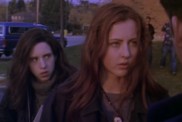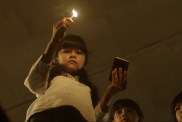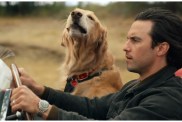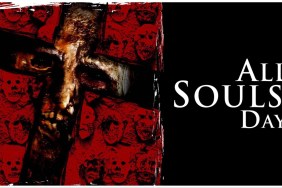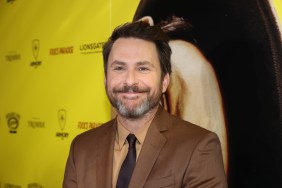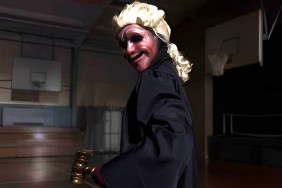On the 30 Days of Night sequel

These are Dark Days for director Ben Ketai.
Based on the second graphic novel in the series by writer Steve Niles, the direct-to-DVD 30 Days of Night: Dark Days finds Ketai continuing what director David Slade started with 2007’s Alaska-set vampire bloodbath. While Dark Days marks Ketai’s feature film directorial debut, he’s no stranger to the 30 Days of Night universe. He previously directed the spin-off web series 30 Days of Night: Dust to Dust for Sam Raimi’s Ghost House Pictures. Ketai co-wrote Dark Days with Niles
Dark Days picks up where 30 Days of Night left off, with sole survivor Stella Oleson (Kiele Sanchez, replacing Melissa George) still grieving for her dead husband Eben while trying to convince a skeptical public that bloodsuckers wiped out the residents of the Alaskan town of Barrow, not an oil fire. When she arrives in Los Angeles, Stella joins forces with a team of hunters out to track down and destroy the nest ruled by the vampire queen (Mia Kirshner) responsible for the Barrow massacre. Little does Stella know that her quest for revenge will lead her back to Alaska.
ShockTillYouDrop spoke with Ketai after Dark Days received its world premiere at Fantastic Fest 2010 in advance of its October 5 DVD and Blu-Ray release.
ShockTillYouDrop: At what point was the decision made to do a direct-to DVD sequel rather than one for theatrical release?
Ben Ketai: Pretty much from the beginning. The budget we had to work with was a fraction of what the first film [had]. It was just part of the plan. The first one did really well on DVD and overseas, and I think they saw an opportunity there to capitalize on that with a sequel. So we just went for it, straight to DVDâ¦. I hadn’t directed a film yet. I knew there would be challenges that would come it because if it’s direct to DVD you’re not going to have enough time to shoot the film or as many toys in your bag of tricks. It’s about being creative and watching the clock and managing your time.
Shock: When did you get involved as director?
Ketai: When Steve [Niles] and I were finishing up the script. The door had been opened to that for some time, and while we were working on the script I got the opportunity to go in and pitch for it, share my vision with them, and that was that.
Shock: It must have helped that you worked on the 30 Days of Nights web series.
Ketai: That was a big part of me getting to write the script and work with Steve Niles and to continue to be involved in that universe. So it definitely helped.
Shock: There’s a perception that direct-to-DVD sequels are a money grab. But in the case of Dark Days, having Niles return to co-write the sequel must lend it instant credibility.
Ketai: It was hugely important. The first film did a great job of staying true to the tone and the themes that the first graphic novel instilled. In order for us to be able to do that on this film, it was important for Steve to be there and help me decide what was going to be important to maintain and what was going to be important to change in order to translate to the screen. We all really wanted to stay true to the [second] graphic novel, and obviously Steve did, too. It was great to have him aboard to do that.

Shock: How faithful is Dark Days to the graphic novel? And what deviations did you make?
Ketai: It’s very faithful to the second graphic novel. There are obviously things we had to do to deviate from it as well, just like the first movie did, just like any graphic-novel movie has to because [with] graphic novels, the storytelling, the narrative arc are so much different than onscreen in a feature film. We introduce some new characters, the vampire hunters Stella meets up with. In the graphic novel they are just mercenaries that don’t really have any background or history together. We try to flesh out their stories a little more and make them more dynamic characters and find ways for them to relate to Stella and use that to try and give it a more cinematic arc the film.
Shock: Was there any thought about doing an original film rather than adapt the sequel graphic novel?
Ketai: It was pretty much always going to be the second graphic novel. The web series gave us opportunities to explore tangential worlds of the 30 Days ⦠universe, and hopefully there will be even more of those for us to have more fun and deviate from the original narration. But as far as a sequel feature goes, the decision was made really early that this has to be Dark Days. The fans of the graphic novel really loved Dark Days, and that’s what we wanted to run with.
Shock: Dark Days doesn’t compromise in terms of its downbeat ending involving the grieve-stricken Stella. Did going to DVD make it easier for you to retain the graphic novel’s ending? Your core audience likely will be fans of the graphic novels that would seek out the film no matter and probably would be upset and disappointed if you changed the ending.
Ketai: It definitely helps on DVD. There’s a different audience, a different expectation when you have a direct-to-home video horror film. I think you can be a little more bold, not just in the way you use gore and your aggressiveness with violence, but in the storytelling, too. You’re not as tied to the classic clichés of theatrical films. We definitely took the opportunity to be as dark and as unsettling as we could.
Shock: What are your thoughts on the actions Stella takes at the end? Is it selfish? Or a misguided act born out of grief?
Ketai: What I loved about in the graphic novel and what I love about it in the film is that it’s tied to who she is. It is a tragedy âthe ending is a tragedyâbut whatever happens, happens, at the very end, in the last frame of the movie. But the tragedy to me is that she went through this entire journey, grew as a character, and then at the end still can’t move on. [SPOILER ALERT:] So the decision to dig up her dead husband’s bones and bleed herself onto him, that to me is the tragedy [SPOILER ENDS]. The results are incidental. I just thought it was beautiful in the graphic novel how that came into play.

She was very busy at the time. The movie had been delayed for a little bit, just in getting up and going. Nobody was really sureâwe were still deciding whether we were going to do a theatrical or a straight-to-DVD sequel. By the time we actually had the chance to go make the movie, it was like now or never, and Melissa was pretty much unavailable for the next year, I think. So there was no way to make that happen.
Shock: What led you to Kiele Sanchez?
Ketai: After Melissa bowed out, we had ⦠I shouldn’t say bowed out. After Melissa was not available at all, we had a rigorously casting process of weeks and weeks of reading actresses. Kiele was actually someone we had our eye on. She had actually read for the role of Stella in the first film. She was very close to getting it, but I think she had a conflict when she was on Lost. We definitely took a good look at her. She has a realism about her and a vulnerability and an edge all wrapped into one. It’s a great way to take that next step with the character.
Shock: She gives a different performance. She’s darker, tortured. But you can accept that because Stella’s not in the same place where she was before the vampires descended on Barrow. Was it easier for Kiele to take over the role because Stella now possesses this warrior mentality?
Ketai: Definitely. When we first started meeting about the film and the character, she watched the first movie, did her research on who Stella was in the first movie, and then read the graphic novels in and out. At the end of the day, what we decided was, Stella makes such a huge change as a character from the first film because of what happened to her and the posttraumatic stress of this event, spending the last year brooding and wallowing in those sensations, that she’s going to be a very different person. So I think it’s kind of cool the way it worked out. It’s fate that it is a different actress because it is a different person.
Shock: Was the casting of Lost‘s Harold Perrineau, as one of Stella’s fellow vampire slayers, a happy accident?
Ketai: It was incidental. Kiele and Harold carry that cache now having been on Lost. Regardless of that, they have their own fanship. Harold has been around forever and he’s done so much magnificent work. He’s such a great actor. Kiele’s got a following from other things she did before Lost. There’s a lot of obvious casting choices for a film like this, but we wanted to take the next step away from that and go with people who would bring some realism and believability to the characters. The whole Lost things was a coincidence.
Shock: What about staging the film’s final confrontation on the ship that transports the vampires from one feeding ground to the next? Were you aware that “Arcadia” in Resident Evil: Afterlife was not a safe haven in Alaska but actually a cargo ship? While Resident Evil is about zombies, do you think it has stolen some of Dark Days‘ thunder?
Ketai: We definitely were not aware of the Resident Evil coincidence. Back when we were writing the script, the ship was actually one of the major things that deviated from the graphic novel. At the end of the graphic novel, they end up in a big mansion in Los Angeles. Steve and I were trying to think of a way to elevate that to make it a more exciting third act for the film. Steve suddenly called me one day and said, “What about the ship from the first movie? That’s how they get around. It’s much more dangerous than a house because a ship can go anywhere. A ship can end up back in Alaska. It made sense in that regard, it made sense in that it was a nice change in visuals and setting from the rest of the film. It seemed like a very serviceable third act.

Definitely. And there’s talk of it in other tangents of the 30 Days ⦠universe and other graphic novels.
Shock: It also brings everything full circle, as you’re back in Alaska. But where do things go from here if there is to be a third film?
Ketai: It all depends on a number of things, including if Kiele would want to come back. I don’t think we would want to change actresses again. We haven’t really discussed anything. There is a third graphic novel, and Steve and I have really been hoping that we get to do that one just because it’s a really cool story. It takes place back in Barrow. The vampires come back to Barrow, and this time the townspeople are ready for them. It turns into an all-out war.
ShockTillYouDrop: Can that be pulled off on a DVD sequel budget?
Ketai: That would be a concern for sure. After having been through this process, shooting in grungy alleys and warehouses and stuff that are supposed to be the underbelly of Los Angeles is much cheaper than having to construct an entire town in the snow, as Iâm sure everybody learned from the first film. So it would be tricky to pull that off I think on the same budget that we had for this film. But we’ll see what happens.
Shock: Being a first-time feature film director, were there any advantages to making your debut on a direct-to-DVD project rather than a theatrical release?
Ketai: I have not directed a theatrical studio film, so I don’t know how to compare those experiences. I think that, being direct to DVD, there is a little less pressure⦠there’s less cooks in the kitchen, I guess. There’s less people talking in your ear. They do give freedom to try things that you weren’t able to do in a theatrical feature, like the ending that we have, like the kills, the nihilistic behavior of the film itself.
Shock: You already had an established working relationship with Sam Raimi. What advice or help did he give you during Dark Days‘ shoot?
Ketai: Sam was a great guide through all this. He’s always been a huge fan of the graphic novels and really did a great job of helping the script find its voice. While we were shooting the film, he unfortunately was not in Vancouver with us. He was watching dailies and sending us little notes here and there, saying good job and giving us a lot of motivation. He’s been great like that. If there’s anything that he’s taught me on a consistent basis, it’s about economy and trimming things here and there that you don’t realize you don’t need. He’s always been great like that, and it’s present in all his films as well.

Not at the moment. While we’re waiting for the DVD to come out I’m just taking the opportunity to write some specs I’ve been working on, and I’m talking about a couple ideas with Ghost House right now. I want the next thing I do to be something special and close to my heart. I have an arsenal of ideas that I’ve wanted to develop and bring to life. So I’m just fleshing those out right now.
Shock: You’re an executive producer of FEARnet’s undead spoof Zombie Roadkill. Are there plans to continue the web series after all its 5-minute episodes are posted online?
Ketai: It all depends on FEARnet if they want to do more web series. We haven’t really discussed that yet. We’re all still enjoying the moment of having completed this first one.
Shock: While you weren’t involved as a writer, does Zombie Roadkill reflect your taste in comedy when it comes to horror spoofs?
Ketai: It reflects [director] David Green and [writer] Henry Gayden’s humor a lot. Personally, it’s not a ⦠I’ve never made anything like that before. But I really enjoy the hell out of watching it and I enjoyed working the hell out of working with those two guys. They have such a great sense of humor that I admire. I wish I had that in me to go do something like that. My stuff usually ends up being way too dark. Kudos to them. It’s a really tough balance to horror and the comedy.





Source: Robert Sims
